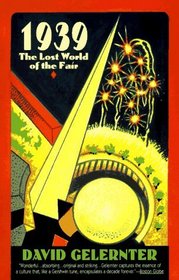This book may not be everyone's cup of tea but I love to learn history through historical novels. Gelernter makes clear that even during the darkest days of the 1930s when economic hardship and the rise of dictatorships around the world so threatened the idea of a free nation, there was also great hope in a better future through technology. From television to wonder drugs, a utopia seemed within reach. Gelernter weaves exhaustive detail about the fair into his novel and at times I found it almost too much.
I now have a different perspective on the 30s and new thoughts about the dilemmas of today. Much to think about, thanks to this book.
I now have a different perspective on the 30s and new thoughts about the dilemmas of today. Much to think about, thanks to this book.
I recently read Tom Hanks' book of short stories: Uncommon Type. One of the stories in the book was about a man who time travels back to 1939 and visits the World's Fair in New York. I found this story to be quite enchanting and remembered that I had a book about the 1939 Worlds Fair so decided to read it.
Overall, I was a little mixed on this one. It provided a lot of information on the fair and interwove a fictional love story into the book about two young people who visited the fair. The woman kept a detailed diary of the visit and this was used as a way of describing the fair attractions. The book also provided a lot of information on America in 1939 including the habits and ways of the people. People were much more proper back then wearing suits and dresses everyday and using manners and etiquette that have long since gone by the wayside. The fair came about at the end of the Depression and right before WWII. And with all that was going on in the world the fair's message was that the future was going to be bright for most Americans with a utopia-like-world projected for 1960. The fair focused on technology including the introduction of television and even had a robot long before the computer age.
The fair's centerpiece was the Trylon and Perisphere, a tall obelisk placed adjacent to a large sphere. These objects symbolized the future and were used on a myriad of fair promotions and souvenirs. There were many other attractions including Futurama, a display by GM showing the cities and roadways of the future. This was the most popular attraction there. And then there was the parachute jump ride which was dismantled at the end of the fair and moved to Coney Island where it is still an unworking attraction there.
Although the book has a section of photographs, the descriptions in the text were sometimes lacking. I found myself searching online to see photos of many of the fair's attractions and exhibits. I did find the overall information of the fair's history and the mores of the people of the time to be very worthwhile. The interwoven love story that was used as a device for the fair was a little unusual but was also quite interesting. However, a lot of the descriptions were quite dry and I would only mildly recommend this one.
Overall, I was a little mixed on this one. It provided a lot of information on the fair and interwove a fictional love story into the book about two young people who visited the fair. The woman kept a detailed diary of the visit and this was used as a way of describing the fair attractions. The book also provided a lot of information on America in 1939 including the habits and ways of the people. People were much more proper back then wearing suits and dresses everyday and using manners and etiquette that have long since gone by the wayside. The fair came about at the end of the Depression and right before WWII. And with all that was going on in the world the fair's message was that the future was going to be bright for most Americans with a utopia-like-world projected for 1960. The fair focused on technology including the introduction of television and even had a robot long before the computer age.
The fair's centerpiece was the Trylon and Perisphere, a tall obelisk placed adjacent to a large sphere. These objects symbolized the future and were used on a myriad of fair promotions and souvenirs. There were many other attractions including Futurama, a display by GM showing the cities and roadways of the future. This was the most popular attraction there. And then there was the parachute jump ride which was dismantled at the end of the fair and moved to Coney Island where it is still an unworking attraction there.
Although the book has a section of photographs, the descriptions in the text were sometimes lacking. I found myself searching online to see photos of many of the fair's attractions and exhibits. I did find the overall information of the fair's history and the mores of the people of the time to be very worthwhile. The interwoven love story that was used as a device for the fair was a little unusual but was also quite interesting. However, a lot of the descriptions were quite dry and I would only mildly recommend this one.




